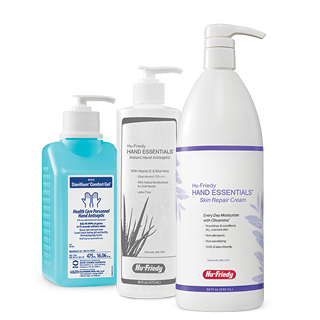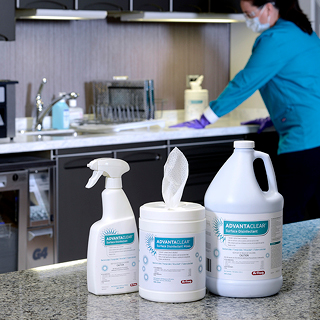Blog
Prevent Infections with these Helpful Tips

Revisit our most popular infection prevention blogs, webinars, and eBooks for advice, resources, and reminders to help ensure a safe environment for your patients and staff
If you've been watching the news you know that infection prevention is top of mind. Moreover, it’s still flu season, and the CDC estimates that there have been between 32 and 45 million cases of the flu from October through the third week in February. Many of those cases go untreated, raising the risk of unpredictable contamination in public spaces – including your dental practice.
Given these conditions, now more than ever, it's critical to ensure your practice is prepared. To help, we've compiled our most popular infection prevention resources and best practices in one place, and while some suggestions may seem obvious, it’s important to remember the basics. Additionally, for a comprehensive, in-depth overview of infection prevention procedures, be sure to check out our Essential Guide to Infection Control eBook.
- Reminders on proper hand hygiene techniques
Hand hygiene is generally considered to be one of the most effective ways to prevent the spread of infections in healthcare settings, yet the CDC suggests that healthcare providers clean their hands less than half the time they should. Proper hand hygiene practices should include the use of all the following: plain or antimicrobial soap, alcohol-based hand sanitizers, and skin moisturizers.

For dental examinations and nonsurgical procedures, clinicians can use soap (plain or antimicrobial) and water or an alcohol-based hand antiseptic to clean or disinfect hands prior to donning exam gloves and immediately following their removal. When hands are visibly soiled, they should always be washed with soap and water first. It is also always good practice to ensure hands are completely dry before donning a new pair of gloves as wet hands can attract pathogens.
Also, be sure to make use of medical-grade, glove compatible hand moisturizers to avoid dry skin or conditions such as dermatitis. Healthy, unbroken skin is the body’s natural defense against infections, and hand washing – though absolutely necessary – can compromise that defense. The use of therapeutic cream can restore the skin’s natural moisture barrier while delivering necessary nutrients to the skin.
For more info on proper hand hygiene techniques, check out our in-depth blog post covering best practices: https://www.hu-friedy.com/blog/hand-hygiene-day
- Review your personal protective equipment (PPE) use
PPE effectively covers personal clothing and skin likely to be soiled with blood, saliva, or other potentially infectious materials. The PPE that should be made available includes gloves, face masks, protective eyewear (for both the clinicians and patient), face shields, and protective clothing.
Among those categories, it’s important to understand the specific needs of each equipment type. For example, different gloves are required for exams, surgical procedures, and cleaning and reprocessing. Unlike exam or surgical gloves that are single-use, some utility gloves can be sterilized, washed, or disinfected for reuse. Be sure to change exam gloves between patients and remove any glove that has been torn, cut, or otherwise compromised. When doing so, make sure to follow hand hygiene procedures before getting replacements.
Does your practice use all required PPE? Review this primer on infection control to ensure you’re on the right track: https://www.hu-friedy.com/blog/coming-clean-infection-control-dental-office
- Ensure proper instrument sterilization and room turnover between patients
Instrument reprocessing plays a central role in preventing the transmission of infections. Dental instruments come into contact with – and can often penetrate – patient soft tissue, which means they can potentially harbor infectious microbes. Our blog on the 6 Critical Steps for Cleaning and Protecting Your Dental Instruments gives a good overview of the reprocessing requirements. One major takeaway is that using an Instrument Management System (IMS™) is the safest and most compliant way to ensure proper reprocessing because instruments remain within a cassette throughout the entire process, avoiding any potential for contamination or sharps injuries.

It’s also important to remember that sterilizing equipment needs to be monitored to ensure it is in top working condition. That requires understanding the basic components of a sterilizer and how to use biological, mechanical, and chemical indicators to measure performance. For more info on proper sterilization techniques, review this post: https://www.hu-friedy.com/blog/sterilization-critical-guidelines
Additionally, there’s often a time-crunch between patients, but proper room turnover is critical to combatting the spread of infections. Surface disinfectants like AdvantaClear are powerful resources. With a one-minute kill time for over 30 different pathogens (and a two-minute kill time for TB), it is effective in a time-crunch. Additionally, as a ready-to-use liquid or wipes, there’s no need to measure, dilute, and mix – meaning fewer opportunities for user error.
For more on room turnover and disinfecting environmental surfaces, this webinar covers the basics.
- Appoint an Infection Control Coordinator to manage practice policies
CDC guidelines state that all practices should designate an Infection Control Coordinator (ICC) who is knowledgeable about infection control and willing to be educated above and beyond to ensure their practice complies with the latest standards and guidelines. Often, it can be all too easy to let infection prevention practices slide given the hustle and bustle of everyday roles, but appointing an ICC creates a direct line of responsibility for ensuring proper procedures.
This person can play an important role in setting policies for the practice, including the best practices discussed here. They can also set the tone for the practice and provide training opportunities for other staff members – for instance on how to identify and evaluate flu symptoms in patients and staff. Any staff member that develops symptoms should be instructed to stay home until their symptoms have cleared. Additionally, consider asking patients to reschedule their appointments if they have flu symptoms, and if possible, waive any cancellation fees to be considerate.
Of course, it is not up to the ICC alone to ensure proper infection prevention. While the ICC is a key driver of an infection prevention program, it is ultimately a team activity that requires buy-in from the whole staff.
The Essential Guide to Infection Control provides a basic overview of the ICC role and its responsibilities, and the GreenLight Dental Compliance Center™ has a resources section dedicated to the needs of the ICC.
The importance of being vigilant
With the flow of patients through your practice each and every day, it’s inevitable that you will encounter a scenario where infectious pathogens are present, despite your best efforts. That is why it is critical to remain vigilant and to follow through on infection prevention best practices. Arm your office with the right tools, training, and information, and you'll be well on your way to maintaining the health of not only your staff and colleagues, but your patients, their families, and the community at large.

